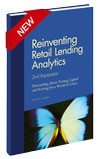Santa Fe, NM 87505
Publications
The following publications are available for purchase or download.
Mass Extinctions: Natural and Financial
April 27, 2020 Click here for the paper.
These are the Times That Try One's [Machine Learning Models]
March 31, 2020 Click here for the paper.
COVID-19 Recession: Hope for a Sprint, Plan for a Marathon
March 31, 2020 Click here for the paper.
Why your Stress Test Model will Over-predict Losses for the COVID-19 Recession
March 1, 2020 Click here for the paper.
Quantifying the Alternatives: Applying CECL to Credit Cards
March 1, 2020 Click here for the paper.
Predicting Economists: Generating Scenarios for Stress Testing Future Loss Reserves
January 7, 2020 Click here for the paper.
In Regards to Proposed Rule 10-17-19 Interagency Policy Statement On Allowances For Credit Losses
December 15, 2019 Click here for the paper.
Dear Congress: Don't toss CECL out, work with FASB to amend it
July 2, 2019 Click here for the paper.
When Big Data Isn't Enough
March 1, 2019 Click here for the paper.
The new standard for loss reserve estimation, Current Expected Credit Loss (CECL), is causing major changes in the financial services industry. We have essential research results to help you make the right choices:
Living with CECL: Mortgage Modeling Alternatives, 2018.
This is an exhaustive study of how to apply CECL to term loans. Many model types, CECL details, and assumptions were tested. The book provides complete details on the methods and results.
Available on Amazon here.
Living with CECL: The Modeling Dictionary, 2018.
For those new to modeling and forecasting, just defining the terms can be difficult. In fact, several early presentations on CECL failed to use terms consistently with the academic literature. This "Dictionary" defines essential terms and modeling techniques in a way that connects to the academic literatures.
Available on Amazon here.
CECL Procyclicality: It Depends on the Model
Sep 14, 2018
The benefits of CECL depends upon how much early warning is provided to crises. The answer, however, depends completely on the model.
Click here for the paper.
Consumer Risk Appetite, the credit cycle, and the housing bubble
May 16, 2018
Recently published in the Journal of Credit Risk,
this paper describes the economic motivations behind shifts in consumer
demand for credit. In doing so, it discusses how the factors can be used to predict
shifts in credit risk that are missed by existing credit scores.
Click here for the paper.

Reinventing Retail Lending Analytics, 2nd Impression, Riskbooks, 2014.
This is the definitive text on forecasting and stress testing for retail lending portfolios. It describes the algorithms, problem designs, and validation techniques that provide the most robust solutions for these loan portfolio. It also extends this framework to economic capital and loan-level modeling.
Available on Amazon here.
Introduction to Portfolio Analysis
This series of papers in the RMA Journal provide a basic introduction to all aspects of portfolio analysis.
- "Becoming a Better Vintner", RMA Journal, September 2002.
- "Portfolio Forecasting Tools: What You Need to Know", RMA Journal, September 2003, pp. 78 - 87.
- "Stress Testing Retail Loan Portfolios", RMA Journal, October 2004.
- "Universal Laws of Retail Economic Capital", RMA Journal, March 2006, pp. 48 - 51.
- "Retail Portfolio Optimization", RMA Journal, October 2006, pp. 38 - 43.
- "Pricing Loans with Real PD Forecasts", RMA Journal, February 2014.
Other Trade Publications on Retail Lending
- "The US Mortgage Crisis: What the Models Missed", National Mortgage News, March 4, 2011.
- "Comment on Proposed NCUA Guidance on Interest Rate Risk", www.ncua.gov, March 23, 2011.
Academic Publications on Retail Lending Analytics and Validation
- "Modeling Data with Multiple Time Dimensions", J of Computational Statistics and Data Analysis, Vol. 51, Issue 9, March 15, 2007, pp. 4761-4785.
- “Stress-testing retail loan portfolios with dual-time dynamics,” The Journal of Risk Model Validation, 2(2), Summer 2008, pp. 43-62.
- “The Relationship Between Default and Economic Cycle Across Countries for Retail Portfolios,” The Journal of Risk Model Validation, 2(3), Autumn 2008.
- “Survey of Retail Loan Portfolio Stress Testing,” in Stress Testing for Financial Institutions, Eds. H. Scheule and D. Roesche, RiskBooks, 2008.
- “Monte Carlo Scenario Generation for Retail Loan Portfolios”, Journal of Operations Research, v.61, pp.399-410, March 2010.
- "Moving from Rankings to Ratings", Proceedings of the Credit Scoring and Credit Control Conference XI, Edinburgh, August 2009.
- "Specification Errors in Stress Test Models", Proceedings of the Credit Scoring and Credit Control Conference, Edinburgh, August 2009.
- "Testing retail lending models for missing cross-terms", Journal of Risk Model Validation, 4(4), Winter 2010.
- "A through-the-cycle model for retail lending economic capital", International Journal of Forecasting, May 2011.
- "Estimating the Effects of Adjustable Rate Mortgage Resets", Proceedings of the Credit Scoring and Credit Control Conference XII, Edinburgh, 2011.
- "Macroeconomic Adverse Selection: How Consumer Demand Drives Credit Quality", Proceedings of the Credit Scoring and Credit Control Conference XII, Edinburgh, 2011.
- “Incorporating Lifecycle and Environment in loan-level forecasts and stress tests”, Proceedings of the Credit Scoring and Credit Control Conference XIII, Edinburgh, 2013
- “A mean-reverting model to create macroeconomic scenarios for credit risk models”, Journal of Risk Model Validation 9(4), 1–12, 2015.
- “Consumer risk appetite, the Credit Cycle, and the Housing Bubble”, Working Papers, Research Department, Federal Reserve Bank of Philadelphia, No. 16-05, 2016.
- “Instabilities using Cox PH for forecasting or stress testing loan portfolios”, Proceedings of the Credit Scoring and Credit Control Conference XIV, Edinburgh, 2015.
- “Solutions to Specification Errors in Stress Testing Models”, Journal of the Operational Research Society, 2016.
- “Incorporating lifecycle and environment in loan-level forecasts and stress tests”, European Journal of Operational Research, 2016.